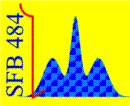
Second International Workshop 2004
Ordering Phenomena in Transition Metal Oxides
September 26 - 29, 2004, Wildbad Kreuth
|
Welcome Pictures taken at the Workshop Invited Speakers Program Poster Session Social Program Organization Technical Information Travel Information Weather SFB 484 Institute of Physics |
|
Invited Talk
|
|
| L. H. Tjeng (Köln) and D. I. Khomskii | |
|
The role of spin and orbital degrees of freedom in metal-insulator
transitions in oxides*
|
|
|
The metal-insulator transitions (MIT) in early transition metal
oxides such as V2O3 and VO2, are
considered to be classical examples of Mott transitions in which the
interplay between band formation and electron correlation causes the
crossover between the metallic and insulating regimes. Despite the
large amount of experimental and theoretical work carried out in the
last 40 years, several fundamental characteristics of these MIT's
seems to have been neglected, one of them being the observation that
the transition temperatures are generally orders of magnitude
smaller in energy scale than the band gaps that are opened in going
from the metallic to the insulating phases. It is only very
recently, that with the development of dynamical mean field theories
(DMFT) one is beginning to have a handle on this problem [1]: for
V2O3, as an example, one is now able to
produce out of the metallic state an insulating state with a
reasonable band gap by using the realistic small changes in the
one-particle band structure parameters.
There are, nevertheless, several issues that are not yet dealt with properly. For example, the experimental valence band spectrum of metallic V2O3 reveals an appreciably stronger quasi-particle peak than in the DMFT calculation[2]. Another example is that the insulating phase in VO2 cannot be reproduced by DMFT using realistic band structure parameters [3]. Very recently, we have carried out bulk sensitive photoemission experiments on VO2 [this talk], and discovered that the spectral weight change across the MIT is in fact much more dramatic than for the V2O3 case, revealing the shortcomings of the DMFT even more clearly. Moreover, the relation of the MIT with the very low transition temperatures has still not been addressed. To understand the spectacular changes in the spectral weight and band gap across the MIT, we infer that it is crucial to consider the k-dependence of the self-energy, and in particular, the inter-site spin-spin correlations. These aspects are essentially neglected in the above mentioned single-site DMFT. On the example of a cluster of two V ions, Park et al. [4] demonstrated the dramatic increase in the effective band widths and decrease of the band gaps that one can obtain if the inter-site spin-spin correlation is switched from antiferromagnetic (AFI) to ferromagnetic (FM) across the MIT. For V2O3, much of the action is expected to take place in the honeycomb lattice of the basal plane (and probably not in the often thought c-axis dimer, since this is already FM in the AFI phase), and for VO2 in the dimer singlet formation. In this respect, it is extremely exciting that using a cluster-DMFT calculation, Liechtenstein et al. [DPG March 2004 Meeting in Regenburg] were able to reproduce much of the spectral weight changes across the MIT in VO2, thereby supporting these ideas. We would like to remark that the idea of the possible importance of spin-spin correlations for the MIT has been explored early on by Bulaevskii and Khomskii [5]. We infer that to make this mechanism to be effective, it is required that the spin-spin correlations are changed drastically and on a short range scale across the MIT. Spectroscopic measurements on V2O3 [4] and VO2 [this talk] reveal that across the MIT the orbital occupations of the 3d shell are dramatically altered. This apparently is an effective and quite natural manner to drastically change the spin-spin correlations, and, in turn, the band widths and band gaps. *This work is done in collaboration with M.W. Haverkort, T. Koethe, Z. Hu, C. Schußler-Langeheine (Univ. Cologne), W. Reichelt (TU Dresden), A. Tanaka (Hiroshima Univ.), O. Tjernberg (KTH-Sweden), F. Venturini, N.B. Brookes (ESRF Grenoble), H.H. Hsieh, H.-J. Lin, T. Chen (SRRC Taiwan) and is supported by the Deutsche Forschungsgemeinschaft through SFB 608. [1] See review by G. Kotliar and D. Vollhardt, Physics Today March 2004 issue, p.53. [2] S.-K. Mo, J.D. Denlinger, H.-D. Kim, J.-H. Park, J.W. Allen, A. Sekiyama, A. Yamasaki, K. Kadono, S. Suga, Y. Saitoh, T. Muro, P. Metcalf, G. Keller, K. Held, V. Eyert, V.I. Anisimov, and D. Vollhardt, Phys. Rev. Lett. 90, 186403 (2003). [3] A. Liebsch and H. Ishida, cond-mat/0310216. [4] J.-H. Park, L.H. Tjeng, A. Tanaka, J.W. Allen, C.T. Chen, P. Metcalf, J.M. Honig, F.M de Groot and G.A. Sawatzky, Phys.Rev.B 61, 11506 (2000). [5] L.N. Bulaevskii and D.I. Khomskii. Soviet Physics - Solid State 9, 2422 (1968). |
|
|
previous / next - Invited Speakers - Program |
|
| [ 21-Apr-17 ] | [ http://www.physik.uni-augsburg.de/sfb484/Kreuth2004/abstracts/tjeng.shtml ] |